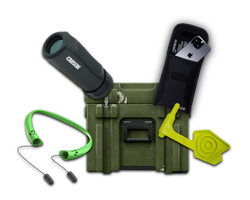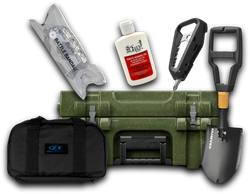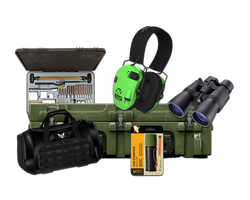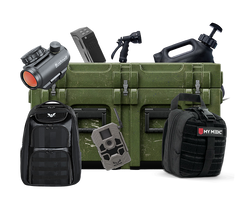How to Improve Target Shooting: Mastering Your Accuracy and Skills
Table of Contents
- Introduction
- Understanding the Basics of Target Shooting
- Advanced Techniques for Enhancing Accuracy
- The Role of Equipment in Target Shooting
- Crate Club Subscriptions: Elevate Your Shooting
- Conclusion
- FAQ
Introduction
Imagine standing at the shooting range, heart racing, as you prepare to fire. The target is set, the gun is in your hands, and you take a deep breath to steady yourself. But as you pull the trigger, you realize that your shot went wide of the mark. This scenario is all too common for many shooters, but it doesn't have to be your reality.
Improving your target shooting is not just about pulling the trigger; it involves a combination of technique, mental focus, and consistent practice. According to seasoned shooters, even minor adjustments can lead to significant improvements in accuracy. The path to becoming a more proficient shooter is paved with knowledge, discipline, and the right tools.
In this comprehensive guide, we will explore various aspects of target shooting, including the fundamentals of marksmanship, techniques to enhance your accuracy, and the importance of mental preparation. By the end of this post, you will have a wealth of information to help you refine your skills and hit your targets more consistently.
Understanding the Basics of Target Shooting
Before diving into advanced techniques, it's crucial to understand the foundational elements of target shooting. Mastering these basics will create a strong platform for improvement.
1. Stance and Grip
Your stance and grip are the first points of contact between you and your firearm. A solid foundation is essential for accuracy.
-
Stance: Stand with your feet shoulder-width apart, with your non-dominant foot slightly forward. This position helps maintain balance and control. Lean slightly forward to engage your core muscles, which can aid in stability during the shot.
-
Grip: Hold the firearm firmly, ensuring that your hands are high on the grip. A strong grip minimizes recoil movement and allows for quicker follow-up shots.
2. Sight Alignment and Picture
The relationship between your eye, the front sight, and the target is vital for accurate shooting.
-
Sight Alignment: This refers to how the front sight sits in relation to the rear sight. Both should be aligned horizontally and vertically. Take your time to ensure that your sights are perfectly aligned before pulling the trigger.
-
Sight Picture: The sight picture combines sight alignment with the target. Focus on the front sight while keeping the target slightly blurred. This technique allows for better precision as you increase your distance.
3. Trigger Control
A common mistake among shooters is jerking the trigger, which can lead to inaccurate shots.
-
Smooth Pull: Practice pulling the trigger in a smooth, controlled manner. Your goal should be to surprise yourself when the shot breaks rather than anticipating the recoil.
-
Dry Fire Practice: Engage in dry fire practice to hone your trigger control without the distraction of recoil. This technique allows you to focus solely on your grip and trigger pull.
4. Breathing Techniques
Breathing plays a crucial role in stabilizing your shot.
-
Controlled Breathing: Inhale deeply, then exhale partially before you shoot. The best time to pull the trigger is at the natural pause after exhaling when your body is relaxed.
-
Avoid Hyperventilation: Ensure your breathing is steady and calm. Rapid or shallow breathing can increase anxiety and lead to instability while aiming.
5. Follow Through
Follow-through is often overlooked but is essential for accuracy.
-
Maintain Position: After firing, keep your position for a moment. This allows you to observe the sight alignment and assess any movement that occurred during the shot.
-
Analyze Your Shots: Take mental notes of where your shots landed relative to your aim. This analysis helps identify areas for improvement in technique.
Advanced Techniques for Enhancing Accuracy
Once you have established a solid understanding of the basics, you can explore advanced techniques to further enhance your target shooting skills.
1. Practice with Purpose
Repetition is key in shooting, but mindless practice won't yield results.
-
Set Goals: Create specific, measurable goals for each practice session. Whether it's refining your grip or improving your speed, having a focus will lead to meaningful progress.
-
Vary Your Drills: Incorporate different drills that challenge various aspects of your shooting. This could include shooting from different positions, engaging moving targets, or adjusting your distance.
2. Use a Shot Timer
A shot timer can add an element of urgency to your practice and help you track your progress.
-
Comstock Mode: This mode allows you to measure how quickly you can fire multiple shots while maintaining accuracy. Aim for smaller splits between shots as you improve.
-
Par Time: Set a limit for how quickly you want to complete a series of shots. This will help build speed without sacrificing precision.
3. Mental Visualization Techniques
Mental preparation is as crucial as physical practice.
-
Visualization: Before you shoot, take a moment to visualize the entire process, from stance to trigger pull. Picture everything going perfectly, reinforcing positive imagery in your mind.
-
Focus on Consistency: Develop a routine that you follow for every shot. Consistency in your mental approach leads to consistency in performance.
4. Seek Professional Instruction
While self-study is valuable, professional guidance can accelerate your learning curve.
-
Find a Mentor: A qualified instructor can provide personalized feedback on your technique, helping you identify and correct bad habits.
-
Join a Shooting Club: Engaging with a community of shooters can offer valuable insights, varied experiences, and camaraderie.
The Role of Equipment in Target Shooting
The right gear can make a difference in your shooting experience. At Crate Club, we offer a variety of tactical gear and survival tools that can enhance your shooting practice.
1. Selecting the Right Firearm
Choosing the right firearm for your needs is essential. Whether you're using a pistol or a rifle, ensure it feels comfortable and fits your shooting style.
- Test Different Models: Don't hesitate to try out different firearms before making a decision. Understanding the ergonomics of each model can significantly impact your performance.
2. Utilizing Quality Optics
Investing in quality optics can aid in accuracy, particularly at longer ranges.
- Sights and Scopes: Ensure your chosen sights or scopes are well-suited for the type of shooting you plan to do. Properly zeroing your optics will enhance your shooting experience.
3. Gear for Practice
In addition to firearms, having quality practice gear can make a difference.
-
Shooting Rest: A shooting rest can stabilize your firearm during practice, allowing you to focus on perfecting your aim.
-
Targets: Use a variety of targets to challenge yourself. Whether it's traditional paper targets or reactive targets, changing your practice routine keeps things fresh and engaging.
Crate Club Subscriptions: Elevate Your Shooting
To further enhance your shooting experience, consider Crate Club's subscription services, which deliver premium tactical gear and survival tools directly to your door.
-
Lieutenant Tier: For just $49.99/month, newcomers to tactical shooting can receive essential gear like fire-starters, EDC tools, and self-defense tools, valued at around $89.
-
Captain Tier: For $99.99/month, shooters can enjoy a curated selection of survival and tactical gear, averaging $153, perfect for everyday use.
-
Major Tier: Experienced shooters can receive premium gear for $199.99/month, with a value of $305, including optics and purification systems.
-
General Tier: For $399.99 quarterly or $1,399.99 annually, the General tier offers high-end tactical gear used by professionals, with a value of $2,244.
Explore our subscription services here: Crate Club Subscription Services.
Additionally, for those looking to purchase top-quality gear, check out our Crate Club Shop for exclusive offerings that can enhance your shooting practice.
Conclusion
Improving your target shooting skills is a journey that requires dedication, practice, and the right mindset. By mastering the fundamentals, employing advanced techniques, and utilizing quality gear, you can elevate your shooting accuracy significantly.
Remember that every shooter, regardless of their experience level, can benefit from continuous learning and refinement of their skills. The road to becoming a proficient shooter is paved with practice, patience, and the willingness to improve.
Are you ready to take your target shooting to the next level? Join the Crate Club community today, and equip yourself with the best tactical gear to support your shooting journey!
FAQ
What are the most important fundamentals of shooting?
The most important fundamentals include stance, grip, sight alignment, trigger control, breathing, and follow-through. Mastering these basics is crucial for accurate shooting.
How can I practice shooting at home?
You can practice dry firing at home by ensuring your firearm is unloaded and using a safe target. Focus on grip, trigger control, and sight alignment during these sessions.
What is the best way to overcome flinching?
To overcome flinching, practice dry firing to build muscle memory and reduce anticipation of recoil. Additionally, consider using snap caps to simulate firing without live rounds.
How often should I practice shooting?
Regular practice is essential for improvement. Aim for at least once a week, but more frequent sessions will yield faster progress.
What type of firearm should I start with?
For beginners, a .22 caliber firearm is often recommended due to its low recoil and affordability. As you gain experience, you can explore larger calibers based on your needs.
Can I improve my shooting without going to a range?
Yes, dry fire practice, visualization, and strength training can significantly improve your shooting skills without needing to go to a range. However, live fire practice is crucial for applying learned skills.
Is there a community for shooters to join?
Yes, consider joining local shooting clubs or online forums where you can connect with other shooters, share experiences, and gain valuable insights from more experienced individuals.
Share this article



